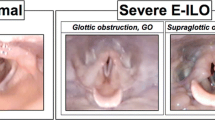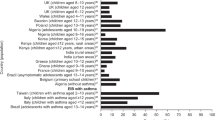Abstract
Respiratory difficulties caused by exercise-induced laryngeal obstructions (EILOs) are reported with increasing frequency. The aim of this study was to assess the prevalence and symptoms of EILOs and their relation to airway hyperresponsiveness (AHR). In total, 556 randomly selected youths in Copenhagen aged 14–24 years were invited over a 2-year period. The study included a mailed questionnaire and two visits: day 1 (an interview-based questionnaire, methacholine bronchial provocation test and physical exertion test); and day 2 [an exercise test with continuous laryngoscopic recordings (CLE test)]. The diagnosis of EILOs was based on the CLE test. In total, 237 answered the mailed questionnaire and 150 participated on day 1 whereof 98 participated on day 2 also. AHR was verified in 23 (4.1% of invitees) and EILOs in 42 (7.5% of invitees). Co-morbidity was verified in 6 cases (26.1% of verified AHR cases). No symptoms were found specific for either AHR or EILOs. The minimum prevalence of EILOs in this cohort was 7.5%. EILOs were verified in 26.1% of participants with AHR. Questionnaires could not differentiate between AHR and EILOs.

Similar content being viewed by others
References
Christensen P, Thomsen SF, Rasmussen N et al (2010) Exercise-induced laryngeal obstructions objectively assessed using EILOMEA. Eur Arch Otorhinolaryngol 267:401–407
Rundell KW, Wilber RL, Szmedra L et al (2000) Exercise-induced asthma screening of elite athletes: field versus laboratory exercise challenge. Med Sci Sports Exerc 32:309–316
Rice SG, Bierman CW, Shapiro GG et al (1985) Identification of exercise-induced asthma among intercollegiate athletes. Ann Allergy 55:790–793
Aaron SD, Vandemheen KL, Boulet LP et al (2008) Overdiagnosis of asthma in obese and nonobese adults. Can Med Assoc J 179:1121–1131
Bateman ED, Hurd SS, Barnes PJ, Bousquet J, Drazen JM, FitzGerald M et al (2008) Global strategy for asthma management and prevention: GINA executive summary. Eur Respir J 31:143–178
Yan K, Salome C, Woolcock AJ (1983) Rabid method for measurement of bronchial responsiveness. Thorax 38:760–765
(2000) Guidelines for Methacholine and exercise challenge testing-1999. The Official Statement of the American Thoracic Society. Am J Respir Crit Care Med 161:309–329
Heimdal JH, Roksund OD, Halvorsen T et al (2006) Continuous laryngoscopy exercise test: a method for visualizing laryngeal dysfunction during exercise. Laryngoscope 116:52–57
Yurdakul AS, Dursun B, Canbakan et al (2005) The assessment of validity of different asthma diagnostic tools in adults. J Asthma 42:843–846
Maat RC, Roksund OD, Olofsson J et al (2009) Audiovisual assessment of exercise-induced laryngeal obstruction: reliability and validity of observations. Eur Arch Otorhinolaryngol 266:1929–1936
Rundell KW, Spiering BA (2003) Inspiratory stridor in elite athletes. Chest 123:468–474
Seear M, Wensley D, West N (2005) How accurate is the diagnosis of exercise induced asthma among Vancouver schoolchildren? Arch Dis Child 90:898–902
Lakin RC, Metzger WJ, Haughey BH (1984) Upper airway obstruction presenting as exercise-induced asthma. Chest 86:499–501
Bent J, Kim J, Wilson J et al (1996) Pediatric exercise-induced laryngomalacia. Ann Otol Rhinol Laryngol 105:169–175
Bittleman D, Smith R, Weiler J (1994) Abnormal movement of the arytenoids region during exercise presenting as exercise-induced asthma in an adolescent athlete. Chest 106:615–616
Bjornsdottir U, Gudmundsson K, Hjartarson H et al (2000) Exercise-induced laryngochalasia: an imitator of exercise-induced bronchospasm. Ann Allergy Asthma Immunol 85:387–391
Maschka DA, Bauman NM, McCray PB Jr et al (1997) A classification scheme for paradoxical vocal cord motion. Laryngoscope 107:1429–1435
Ruddy BH, Davenport P, Baylor J et al (2004) Inspiratory muscle strength training with behavioural therapy in a case of a rower with presumed exercise-induced paradoxical vocal cord dysfunction. Int J Pediatr Otorhinolaryngol 68:1327–1332
Fallon KE (2004) Upper airway obstruction masquerading as exercise-induced bronchospasm in an elite road cyclist. Br J Sports Med 38:E9
Sullivan MD, Heywood BM, Beukelman DR (2001) A treatment for vocal cord dysfunction in female athletes: an outcome study. Laryngoscope 111:1751–1755
Archer GJ, Hoyle JL, McCluskey A et al (2000) Inspiratory vocal cord dysfunction, a new approach in treatment. Eur Respir J 15:617–618
Kivity S, Bibi H, Schwarz Y et al (1986) Variable vocal cord dysfunction presenting as wheezing and exercise induced asthma. J Asthma 23:241–244
Guss J, Mirza N (2006) Methacholine challenge testing in the diagnosis of paradoxical vocal fold motion. Laryngoscope 116(9):1558–1561
Gurevich-Uvena J, Parker JM, Fitzpatrick TM et al (2010) Medical comorbidities for paradoxical vocal fold motion (vocal cord dysfunction) in the military population. J Voice 24(6):728–731. doi:10.1016/j.voice.2009.03.007
Acknowledgments
The study was funded by an independent grand from the Danish Agency of Science, Technology and Innovation and the University of Copenhagen.
Conflict of interest
None of the authors have any financial affiliation to the organization sponsoring the study.
Author information
Authors and Affiliations
Corresponding author
Rights and permissions
About this article
Cite this article
Christensen, P.M., Thomsen, S.F., Rasmussen, N. et al. Exercise-induced laryngeal obstructions: prevalence and symptoms in the general public. Eur Arch Otorhinolaryngol 268, 1313–1319 (2011). https://doi.org/10.1007/s00405-011-1612-0
Received:
Accepted:
Published:
Issue Date:
DOI: https://doi.org/10.1007/s00405-011-1612-0




